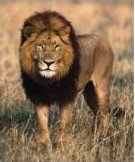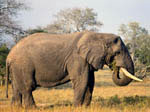|
Lower Zambezi National Park ,
|
The Lower Zambezi Valley, including the LZNP and surrounding Game Management Areas (GMA’s), is rich in biological diversity. The rivers edge is overhung with a thick riverine fringe, mostly diasporus, ficus and other riverine species. Further inland is a floodplain fringed with mopane forest and interspersed with winterthorn trees acacia albida.
The forests, wetlands and natural geographical features form unique and complex ecosystems that support abundant wildlife. The wilderness, landscapes and natural resources are of exceptional value.
The hills on the escarpment along the northern end acts as a physical barrier to most of the parks animal species. These hills as boundary to the park are covered in broadleaf woodland.
The vegetation in the area is predominated by acacia albida trees, a thorn species 10 - 30m high with the classical shady umbrella canopy. It is able to tolerate sandier soils than other woodland species and serves to stabilise infertile sandbanks and reduce erosion. Winterthorn pods are also remarkably nutritious to elephants who digest it leaving about 40% intact, thereby contributing to its proliferation.
Wildlife
 The ecological unit of Lower Zambezi National Park and the Chiawa Game Management Area support a relatively large population of mammals. Although small in area the valley hosts a large number of mammal species including elephant, hippo, buffalo, kudu, zebra, impala, bushbuck, duiker, klipspringer, lion, leopard, African wild dog, serval, aardvark, chac-ma baboon and vervet monkeys. Occasionally roan, eland and the Samango monkey are seen. Crocodiles, as expected, are ubiquitous.
The ecological unit of Lower Zambezi National Park and the Chiawa Game Management Area support a relatively large population of mammals. Although small in area the valley hosts a large number of mammal species including elephant, hippo, buffalo, kudu, zebra, impala, bushbuck, duiker, klipspringer, lion, leopard, African wild dog, serval, aardvark, chac-ma baboon and vervet monkeys. Occasionally roan, eland and the Samango monkey are seen. Crocodiles, as expected, are ubiquitous.

Herds of elephant of up to 100 strong are often seen at the rivers edge and ‘island hopping’ buffalo and waterbuck are common too. The comfort of your canoe makes it blissful to watch animals.
The nocturnal animals are hyaena, porcupine, civet, genet and honeybadger. When approached crocodiles like to slither stealthily into water.
Birdlife
The birdlife along the riverbanks is exceptional. And something more... the park is familiar to the ubiquitous cry of the fish eagle. Many a fish eagle can be seen and heard for miles around. Nesting along the cliffs are white fronted and carmine bee eaters.
Other unusual birds are the red winged pratincole, the elegant crested guinea fowl, black eagle, and vast swarms of quelea. In summer the stunning narina trogon makes its home here. Other specialities are the trumpeter hornbill, Meyers parrot and Lilian’s lovebird. Being bordered by a natural boundary the Lower Zambezi National Park attracts an estimated 400-bird species.
Fishing
Most lodges in the lower Zambezi practice a throwing back policy for small fish.
The sunsets are memorable on the Zambezi River what with the dusky hues of pink and the purple and orange zigzagging across the dark blue waters.
Conservation Lower Zambezi Conservation Lower Zambezi (CLZ) was established by the Safari Tour Operators and Stakeholders within the Lower Zambezi National Park and Chiawa GMA as a non-profit volunteer organization. Registered in 1995 CLZ assists the Zambia Wildlife Authority (ZAWA) and the Chiawa community with conservation efforts.
The goal of CLZ is to safeguard wildlife and its habitat as an asset and a resource in the Lower Zambezi National Park and surrounding GMA’s. So it encourages a throw back policy of small fish.
Conservation Lower Zambezi is a membership-based volunteer organization that has tax exempt status from the Zambian Revenue Authority (ZRA) as well as exemption from VAT & duty on imports. Revenue for project implementation comes from membership fees, private as well as corporate, fundraisers, donations by visitors and the Zambian business community.
However, the majority of funds received over the past 4 years stem from international organisations and sources, among others Danida, the Humba Bush Foundation, Yancey Walker Productions and Afrikeye.
How to Get There
One can drive into the national park on one’s own but it is very underdeveloped and not really structured for vehicle visitors yet. The existing lodges and canoeing operators provide the best access to the park. They all offer pick-ups from either Lusaka or Chirundu (where there is a small motel) or Kariba in Zimbabwe.
The Chongwe River demarcates the western boundary of the park and can be accessed from Chirundu along a rough road (4x4 recommended), crossing the Kafue River by pontoon just beyond Gwabi Lodge. From April there is a pontoon that crosses the Zambezi from Luangwa Town to Kanyemba in Zimbabwe and to Zumbo in Mozambique. …all of this happens at the Zambezi/Luangwa confluence.
Zambia African Safari © ZAS 2004


